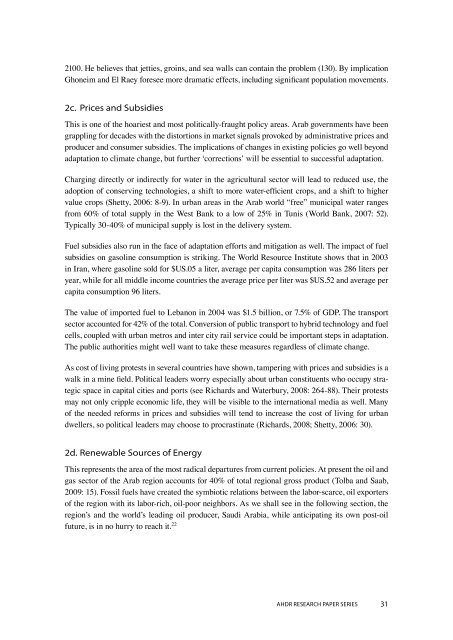The Political Economy of Climate Change in Arab Countries
The Political Economy of Climate Change in Arab Countries
The Political Economy of Climate Change in Arab Countries
You also want an ePaper? Increase the reach of your titles
YUMPU automatically turns print PDFs into web optimized ePapers that Google loves.
2100. He believes that jetties, gro<strong>in</strong>s, and sea walls can conta<strong>in</strong> the problem (130). By implicationGhoneim and El Raey foresee more dramatic effects, <strong>in</strong>clud<strong>in</strong>g significant population movements.2c. Prices and SubsidiesThis is one <strong>of</strong> the hoariest and most politically-fraught policy areas. <strong>Arab</strong> governments have beengrappl<strong>in</strong>g for decades with the distortions <strong>in</strong> market signals provoked by adm<strong>in</strong>istrative prices andproducer and consumer subsidies. <strong>The</strong> implications <strong>of</strong> changes <strong>in</strong> exist<strong>in</strong>g policies go well beyondadaptation to climate change, but further ‘corrections’ will be essential to successful adaptation.Charg<strong>in</strong>g directly or <strong>in</strong>directly for water <strong>in</strong> the agricultural sector will lead to reduced use, theadoption <strong>of</strong> conserv<strong>in</strong>g technologies, a shift to more water-efficient crops, and a shift to highervalue crops (Shetty, 2006: 8-9). In urban areas <strong>in</strong> the <strong>Arab</strong> world “free” municipal water rangesfrom 60% <strong>of</strong> total supply <strong>in</strong> the West Bank to a low <strong>of</strong> 25% <strong>in</strong> Tunis (World Bank, 2007: 52).Typically 30-40% <strong>of</strong> municipal supply is lost <strong>in</strong> the delivery system.Fuel subsidies also run <strong>in</strong> the face <strong>of</strong> adaptation efforts and mitigation as well. <strong>The</strong> impact <strong>of</strong> fuelsubsidies on gasol<strong>in</strong>e consumption is strik<strong>in</strong>g. <strong>The</strong> World Resource Institute shows that <strong>in</strong> 2003<strong>in</strong> Iran, where gasol<strong>in</strong>e sold for $US.05 a liter, average per capita consumption was 286 liters peryear, while for all middle <strong>in</strong>come countries the average price per liter was $US.52 and average percapita consumption 96 liters.<strong>The</strong> value <strong>of</strong> imported fuel to Lebanon <strong>in</strong> 2004 was $1.5 billion, or 7.5% <strong>of</strong> GDP. <strong>The</strong> transportsector accounted for 42% <strong>of</strong> the total. Conversion <strong>of</strong> public transport to hybrid technology and fuelcells, coupled with urban metros and <strong>in</strong>ter city rail service could be important steps <strong>in</strong> adaptation.<strong>The</strong> public authorities might well want to take these measures regardless <strong>of</strong> climate change.As cost <strong>of</strong> liv<strong>in</strong>g protests <strong>in</strong> several countries have shown, tamper<strong>in</strong>g with prices and subsidies is awalk <strong>in</strong> a m<strong>in</strong>e field. <strong>Political</strong> leaders worry especially about urban constituents who occupy strategicspace <strong>in</strong> capital cities and ports (see Richards and Waterbury, 2008: 264-88). <strong>The</strong>ir protestsmay not only cripple economic life, they will be visible to the <strong>in</strong>ternational media as well. Many<strong>of</strong> the needed reforms <strong>in</strong> prices and subsidies will tend to <strong>in</strong>crease the cost <strong>of</strong> liv<strong>in</strong>g for urbandwellers, so political leaders may choose to procrast<strong>in</strong>ate (Richards, 2008; Shetty, 2006: 30).2d. Renewable Sources <strong>of</strong> EnergyThis represents the area <strong>of</strong> the most radical departures from current policies. At present the oil andgas sector <strong>of</strong> the <strong>Arab</strong> region accounts for 40% <strong>of</strong> total regional gross product (Tolba and Saab,2009: 15). Fossil fuels have created the symbiotic relations between the labor-scarce, oil exporters<strong>of</strong> the region with its labor-rich, oil-poor neighbors. As we shall see <strong>in</strong> the follow<strong>in</strong>g section, theregion’s and the world’s lead<strong>in</strong>g oil producer, Saudi <strong>Arab</strong>ia, while anticipat<strong>in</strong>g its own post-oilfuture, is <strong>in</strong> no hurry to reach it. 22AHDR RESEARCH Paper series31
















